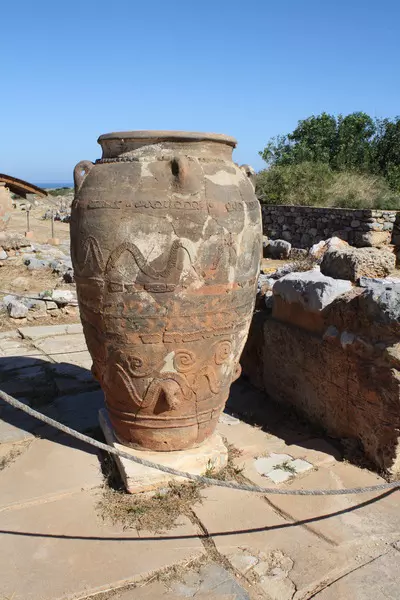Malia(northern Crete)

Pithoi
Located near a fertile plain in northern Crete and with its own harbour, Malia was one of the major settlements and palaces of the Minoan civilization. Inhabited since Neolithic times (6000 BCE) and with the first evidence of monumental architecture dating to 2200 BCE, the site reached its greatest influence during the palatial periods of c. 1900 BCE to c. 1675 BCE. Following earthquakes and fires, the site became less influential and was finally abandoned c. 1250 BCE.
The original name of the settlement has been lost and the site derives its present name from the nearby modern village of Malia. Suggestions as to the original name are Milatos or Tarmara. In Greek mythology, Malia's first king was Sarpedon (the son of Zeus and Europa), younger brother of Minos of Knossos.
Marcher dans la vieille ville de Malia, Crète Grèce 2021, 4K UHD
THERE IS ALSO EXTENSIVE ARCHAEOLOGICAL EVIDENCE SURROUNDING THE PALACE SITE, INCLUDING A TOWN, SMALLER PALACES AND A LARGE CEMETERY.
Along with Knossos, Phaistos and Zakros, Malia was one of the most important Minoan settlements. The palace complex, covering some 7500 square metres, was perhaps the local administrative, commercial, political and religious centre. There is also extensive archaeological evidence surrounding the palace site, including a town, smaller palaces and a large cemetery. Finds of gold and bronze objects, stone vases, extensive pottery, metal, and ceramic workshops, large vases (pithoi and amphorae) and the presence of Malian seal stones throughout central Crete, strongly suggest Malia was a significant trading and commercial centre.
The palace complex was built in two stages. The first palace, built around 1900 BCE, was destroyed c. 1675 BCE, probably by fire and earthquake. The second palace was built soon after, largely on the plan of the first. This palace was also destroyed, once again, probably by earthquake c. 1450 BCE. With the notable exception of the main courts, it is the remains of the second palace which are visible at the site today. The site has been excavated by the French Archaeological School from 1920 CE to the present and is regarded as a showcase site for modern conservation archaeology.
The splendid palaces included all of the principal features of Minoan palatial architecture such as a large central court, a theatre or performance area, colonnades, light wells, rooms of two stories, storage magazines, and private rooms. The palaces were constructed using local sandstone and limestone blocks with many rooms being plastered and painted, including the floors.

Malia, Crete
Visible today are the large central court (48m x 23m and originally with porticoes on the north and west sides) with its central sacrificial hearth and four surviving monumental steps along its south side used as a theatre area, probably, as with the other Minoan palaces, for festivals, rituals and bull leaping games; 7 surviving steps of the monumental Grand Staircase; a 90cm diameter offering stone or Kernos; three, 4m wide circular pits used as grain silos, each with a central column base to support the original roof; the Hypostyle Hall with 6 column bases still in situ; the Hypostyle Crypt with its benched walls suggesting its use as a meeting place; and various other halls, apartments and magazines including one room with a well-preserved stone toilet with drainage system.
Outstanding finds from the site include the celebrated gold bee pendant and ceremonial stone axe in the shape of a panther from the 17th century BCE. These now reside in the archaeological museum in Iraklion, Crete.

Bibliography
Cline, E.H. The Oxford Handbook of the Bronze Age Aegean. Oxford University Press, USA, 2012.
Davaras, C. Malia. Hannibal, Athens
Hutchinson, R.W. Prehistoric Crete. Pelican / Penguin Books, 1963.
Translations
We want people all over the world to learn about history. Help us and translate this definition into another language!
About the Author
Mark Cartwright
Mark is a history writer based in Italy. His special interests include pottery, architecture, world mythology and discovering the ideas that all civilizations share in common. He holds an MA in Political Philosophy and is the Publishing Director at WHE.
https://www.worldhistory.org/Malia/

